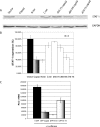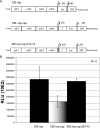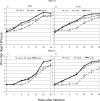A five-amino-acid deletion of the eastern equine encephalitis virus capsid protein attenuates replication in mammalian systems but not in mosquito cells
- PMID: 18480443
- PMCID: PMC2446984
- DOI: 10.1128/JVI.01283-07
A five-amino-acid deletion of the eastern equine encephalitis virus capsid protein attenuates replication in mammalian systems but not in mosquito cells
Abstract
Eastern equine encephalitis virus (EEEV) is a human and veterinary pathogen that causes sporadic cases of fatal neurological disease. We previously demonstrated that the capsid protein of EEEV is a potent inhibitor of host cell gene expression and that this function maps to the amino terminus of the protein. We now identify amino acids 55 to 75, within the N terminus of the capsid, as critical for the inhibition of host cell gene expression. An analysis of stable EEEV replicons expressing mutant capsid proteins corroborated these mapping data. When deletions of 5 to 20 amino acids within this region of the capsid were introduced into infectious EEEV, the mutants exhibited delayed replication in Vero cells. However, the replication of the 5-amino-acid deletion mutant in C710 mosquito cells was not affected, suggesting that virus replication and assembly were affected in a cell-specific manner. Both 5- and 20-amino-acid deletion mutant viruses exhibited increased sensitivity to interferon (IFN) in cell culture and impaired replication and complete attenuation in mice. In summary, we have identified a region within the capsid protein of EEEV that contributes to the inhibition of host gene expression and to the protection of EEEV from the antiviral effects of IFNs. This region is also critical for EEEV pathogenesis.
Figures







Similar articles
-
Hypervariable Domain of nsP3 of Eastern Equine Encephalitis Virus Is a Critical Determinant of Viral Virulence.J Virol. 2020 Aug 17;94(17):e00617-20. doi: 10.1128/JVI.00617-20. Print 2020 Aug 17. J Virol. 2020. PMID: 32581106 Free PMC article.
-
Capsid protein of eastern equine encephalitis virus inhibits host cell gene expression.J Virol. 2007 Apr;81(8):3866-76. doi: 10.1128/JVI.02075-06. Epub 2007 Jan 31. J Virol. 2007. PMID: 17267491 Free PMC article.
-
Cooperativity between the 3' untranslated region microRNA binding sites is critical for the virulence of eastern equine encephalitis virus.PLoS Pathog. 2019 Oct 28;15(10):e1007867. doi: 10.1371/journal.ppat.1007867. eCollection 2019 Oct. PLoS Pathog. 2019. PMID: 31658290 Free PMC article.
-
Eastern equine encephalomyelitis virus: epidemiology and evolution of mosquito transmission.Adv Virus Res. 1989;37:277-328. doi: 10.1016/s0065-3527(08)60838-6. Adv Virus Res. 1989. PMID: 2574935 Review. No abstract available.
-
Eastern Equine Encephalitis Virus: A Case Report and Brief Literature Review of Current Therapeutic and Preventative Strategies.Vector Borne Zoonotic Dis. 2024 Feb;24(2):118-121. doi: 10.1089/vbz.2023.0011. Epub 2023 Oct 23. Vector Borne Zoonotic Dis. 2024. PMID: 37870590 Review.
Cited by
-
Selective Inhibitor of Nuclear Export (SINE) Compounds Alter New World Alphavirus Capsid Localization and Reduce Viral Replication in Mammalian Cells.PLoS Negl Trop Dis. 2016 Nov 30;10(11):e0005122. doi: 10.1371/journal.pntd.0005122. eCollection 2016 Nov. PLoS Negl Trop Dis. 2016. PMID: 27902702 Free PMC article.
-
Rational design of a live-attenuated eastern equine encephalitis virus vaccine through informed mutation of virulence determinants.PLoS Pathog. 2019 Feb 11;15(2):e1007584. doi: 10.1371/journal.ppat.1007584. eCollection 2019 Feb. PLoS Pathog. 2019. PMID: 30742691 Free PMC article.
-
Rational design of self-amplifying virus-like vesicles with Ebola virus glycoprotein as vaccines.Mol Ther. 2024 Oct 2;32(10):3695-3711. doi: 10.1016/j.ymthe.2024.08.026. Epub 2024 Aug 31. Mol Ther. 2024. PMID: 39217415
-
A detailed kinetic model of Eastern equine encephalitis virus replication in a susceptible host cell.PLoS Comput Biol. 2025 Jun 4;21(6):e1013082. doi: 10.1371/journal.pcbi.1013082. eCollection 2025 Jun. PLoS Comput Biol. 2025. PMID: 40465541 Free PMC article.
-
Hypervariable Domain of nsP3 of Eastern Equine Encephalitis Virus Is a Critical Determinant of Viral Virulence.J Virol. 2020 Aug 17;94(17):e00617-20. doi: 10.1128/JVI.00617-20. Print 2020 Aug 17. J Virol. 2020. PMID: 32581106 Free PMC article.
References
-
- Aguilar, P. V., A. P. Adams, E. Wang, W. Kang, A.-S. Carrara, M. Anishchenko, I. Frolov, and S. C. Weaver. 2008. Structural and nonstructural protein genome regions of eastern equine encephalitis virus are determinants of interferon sensitivity and murine virulence. J. Virol. 824920-4930. - PMC - PubMed
-
- Anishchenko, M., S. Paessler, I. P. Greene, P. V. Aguilar, A. S. Carrara, and S. C. Weaver. 2004. Generation and characterization of closely related epizootic and enzootic infectious cDNA clones for studying interferon sensitivity and emergence mechanisms of Venezuelan equine encephalitis virus. J. Virol. 781-8. - PMC - PubMed
Publication types
MeSH terms
Substances
Grants and funding
LinkOut - more resources
Full Text Sources

